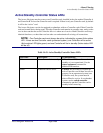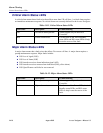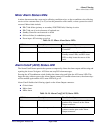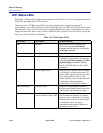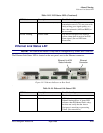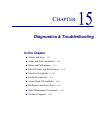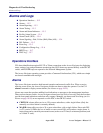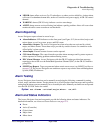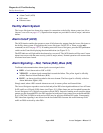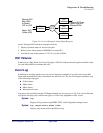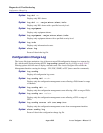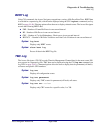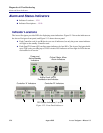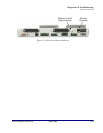
15-2 August 2003 Access Navigator - Release 1.8
Diagnostics & Troubleshooting
Alarms and Logs
Alarms and Logs
n Operations Interface ... 15-2
n Alarms ... 15-2
n Alarm Reporting ... 15-3
n Alarm Testing ... 15-3
n Alarm and Status Indicators ... 15-3
n Facility Alarm System ... 15-4
n Alarm Cutoff (ACO) ... 15-4
n Alarm Signaling – Red, Yellow (RAI), Blue (AIS) ... 15-4
n DS1 Failures ... 15-5
n Event Log ... 15-5
n Configuration Change Log ... 15-6
n BERT Log ... 15-7
n TMC Log ... 15-7
Operations Interface
CLI alarm identification requires RS-232 or Telnet connections to the Access Navigator for displaying
status, settings, logs, and performance monitoring data. EOC alarms are reported directly to the GR-303
switch, while SNMP traps are reported to the Network Management System.
The Access Navigator operating system provides a Command Line Interface (CLI), which uses simple
text based commands and messages.
Alarms
The Access Navigator monitors both internal operation and network traffic flow. When a service-
affecting event occurs, the Access Navigator provides an alarm to alert the operator. Use the CLI
alarms command to display current alarms (see Alarms on page 18-25).
Alarms are events that produce audible/visual indications or messages to the management interfaces.
There are four alarm severities. Access Navigator alarms have five levels of severity. Only the first three
provide front panel indications and alarm relay outputs. Manually set alarms used for testing (see Set
Alarms on page 18-95) are not reported over the EOC to the GR-303 switch.
l CRITICAL alarms affect service to 128 or more subscribers, with a single failure. (Only the
manually set critical alarm is currently defined.)
l MAJOR alarms affect service to 24 or more subscribers, with a single failure. Since each DS1
(or T1) carries 24 DS0s, the loss of traffic on one or more DS1s will produce a major alarm. A
major alarm can be caused by an external event (such as a cut T1 line) or an internal problem (such
as a failed T1 card).




